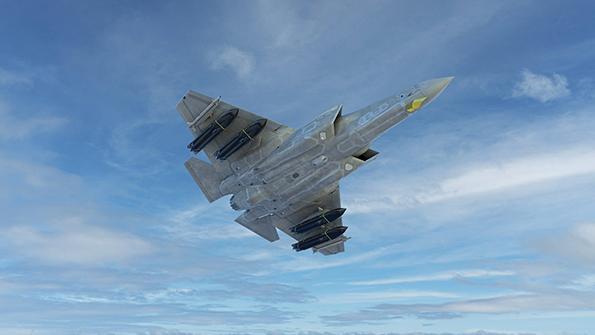
The U.S. Navy’s plans for its future weapons have centered on one critical capability: range.
In a potential conflict in the Indo-Pacific region, ships and carrier-based aircraft would have to engage advanced enemy targets from long distances, especially since China continues to develop advanced long-distance missiles. But that focus is not enough. For the immediate future, the Navy says greater range is useless if a missile is slow because the speed of these weapons is becoming more important.
- AIM-9X and AIM-120 upgrades scheduled ahead of AIM-260
- Competition for HALO contract is emerging
“We need to increase range, but we also need increased speed,” Cmdr. Garth Blakely, aviation weapons officer at the Office of Naval Operations, said on Sept. 10 during the annual Tailhook Association Symposium held outside Reno, Nevada. “We may potentially need increased speed more than increased range at this point.”
As Vice Adm. Kenneth Whitesell, commander of the Naval Air Forces, argues: Do not lose sight on improving the current weapons while making longer-term plans. He added that the U.S. military is rapidly approaching the “Davidson Window”—the warning laid out by former commander of the U.S. Indo-Pacific Command Adm. Phil Davidson that China could attack Taiwan by 2027.
“While I’m concentrating on the range of the weapons with the capability of the weapons, the guidance to end game of the weapons, don’t lose sight on the weapons that you’re producing right now and the upgrades to your capabilities that we have right now,” Whitesell said at Tailhook. “We have some capabilities, we’re going to have some game in the fight.”
To that end, the Navy and Raytheon Technologies are working on more upgrades to the AIM-9Xs and AIM-120 advanced medium-range air-to-air missiles (Amraam) that can be delivered before the Lockheed Martin AIM-260 Joint Advanced Tactical Missile (JATM) is ready. That move is needed “not only to survive but to establish what we know will be required for our primary mission of maritime strike—temporal air superiority,” Blakely said.
For AIM-9X, the Navy is working with Raytheon on the current Block II missile’s system improvement package (SIP) III, which increases the reliability and replaces high-fail parts, Blakely said. The Navy and Raytheon are also developing a follow-on SIP IV to “increase the lethality capability” of the missile, he added.
The Navy is expanding its capacity on the latest Raytheon AIM-120D Amraams: The largest contract in the program’s history was announced in early September. The $972 million deal includes the U.S. along with foreign military sales to 19 other nations. The Navy and Raytheon are working on the SIP III variant of the missile, while simultaneously developing a follow-on SIP IV “refresh of the system” that will improve its ability to target threats across a wide spectrum. This will help bridge the gap as the Navy looks ahead to the Lockheed AIM-260 JATM, along with the Air Force.
“The biggest thing of all is the capacity issue,” Blakely said. “We’re very aware of it, and we’re looking at the cost of what we can possibly do to increase that depth of magazine and get the warfighters on the front line what they need when the time comes.”
For the air-to-surface mission, the Navy and Lockheed Martin are planning to reach initial operational capability for the latest AGM-158 C-1 Long-Range Anti-Ship Missile (LRASM) in 2023, which will increase the range of the cruise missile; further LRASM C-3 upgrades will follow. These efforts are laying the groundwork for the follow-on Hypersonic Air-Launched Offensive Anti-Surface Warfare Weapon Increment II (HALO).
The Navy disclosed its HALO effort in a budget request earlier this year, and the service is now looking for companies to start building prototypes in fiscal 2023. The Navy needs a hypersonic anti-ship missile that is small enough to fit in a carrier-based aircraft without striking the deck and one that can fit in the aircraft carrier’s weapons elevator. The service has budgeted $444 million between 2023 and 2027 for this development; a request for proposals is expected in 2023.
At Tailhook, Boeing unveiled for the first time a model of its hypersonic solid-fuel ramjet missile, previously called the Supersonic Propulsion Enabled Advanced Ramjet (SPEAR). Boeing plans the missile to be a flight demonstrator for the F/A-18. It was originally expected to fly in 2022, though the company did not provide an updated schedule.
The Navy is also integrating the Northrop Grumman Advanced Anti-Radiation Guided Missile Extended Range and the Raytheon GBU-53B/StormBreaker into its fleet in the near term.
The capacity issue covers both air-to-ground and air-to-air missiles, so the Navy wants to find new ways to meet this challenge. Blakely said the service is exploring how to create a low-cost, high-capacity “effector” that could augment high-end aircraft and other systems that are in development. That venture could be similar to the Air Force’s plan for a Standoff Attack Weapon, a new effort to produce a lower-cost long-range missile in a large quantity compared with more expensive missiles and aircraft to deliver them.


